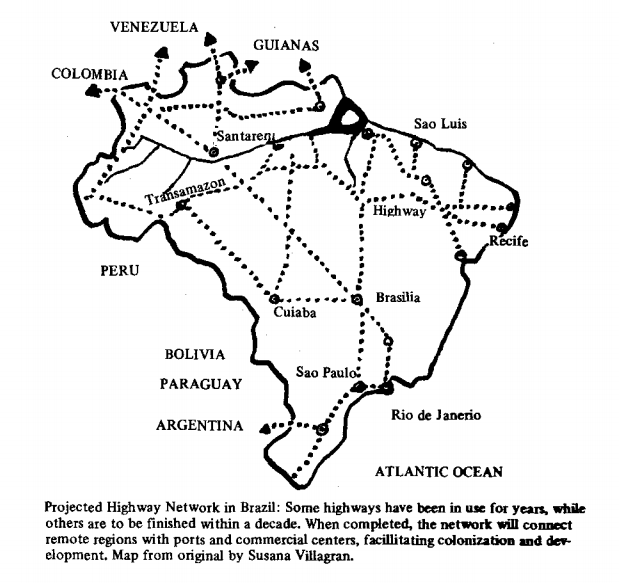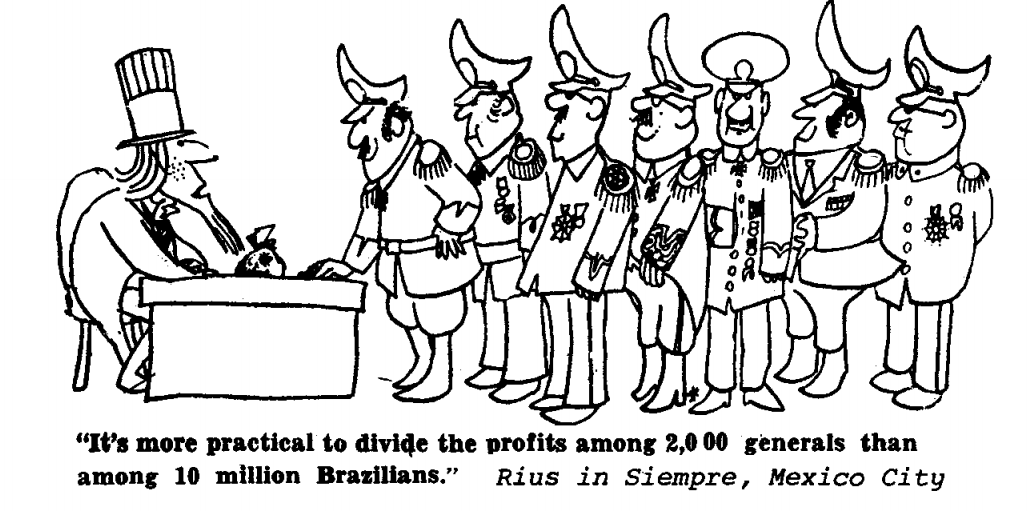This essay is reproduced here as it appeared in the print edition of the original Science for the People magazine. These web-formatted archives are preserved complete with typographical errors and available for reference and educational and activist use. Scanned PDFs of the back issues can be browsed by headline at the website for the 2014 SftP conference held at UMass-Amherst. For more information or to support the project, email sftp.publishing@gmail.com
Pogrom for Progress: Brazil
by Bonnie Mass
‘Science for the People’ Vol. 5, No. 2, March 1973, p. 9 – 13
 In the late twentieth century, the precepts of Reverend Thomas Malthus are being revived, even though nineteenth century capitalists have found them inconvenient and backward. Whereas scientists such as Darwin had demolished the “scientific” basis of Malthus’ predictions and socialist thinkers such as Karl Marx had devastatingly disproved his predictions, Malthusian fears of imminent doom and destruction caused by a “population explosion” have now been reawakened—owing to an energetic publicity campaign by the American power elite.
In the late twentieth century, the precepts of Reverend Thomas Malthus are being revived, even though nineteenth century capitalists have found them inconvenient and backward. Whereas scientists such as Darwin had demolished the “scientific” basis of Malthus’ predictions and socialist thinkers such as Karl Marx had devastatingly disproved his predictions, Malthusian fears of imminent doom and destruction caused by a “population explosion” have now been reawakened—owing to an energetic publicity campaign by the American power elite.
Although Malthus advocated “moral restraint” instead of contraception or other means of reducing population, his present day heirs insist upon the use of any “scientific means” for lowering the birth rate. Believing that “nature” no longer controlled population rates, Malthus had deeply feared widespread scarcity and a degeneration of morality. For him, overpopulation, instead of the rise of industrial capitalism, was responsible for the evils that he attributed to the society of his day.
In referring to his own erroneous laws of geometric population growth, Malthus felt that the upper and middle classes, with the knowledge of these laws firmly in mind, would be able to alter the conditions of the poor “prudently”, but efficiently.
Undoubtedly, one of the most valuable of these effects would be the power that would result to the higher and middle classes of society, of gradually improving their governments, without the apprehension of these revolutionary excesses, the fear of which, at present threatens to deprive Europe even of the degree of liberty which; she had before experienced to be practical, and the salutary effects of which she had long enjoyed. 1(“Let them eat cake” was apparently Malthus’ slogan, too.)
Nevertheless, he partially agreed with the capitalists of his day who contended that industry needed a reserve army of labor. “Prudential habits with regard to marriages, carried to a considerable extent among the laboring class of a country depending mainly upon manufacturers and commerce, might injure it.” 2
Capitalism requires a “reserve labor force” so that production can be stepped up or reduced according to business cycles. Unemployment is not a burden upon capitalism, but an essential part of it. The greater the number available to do a job, the lower the wage level need be, and the higher the profit rate.
Today, in Latin America as in many under-developed regions, although the middle class is prospering and consumtion is rising, the majority of men and women have less food now than they did in 1945. According to Andre Gunder Frank, a “metropolis-satellite” relationship dominates Latin America and other regions of the Third World, causing this lessening of food intake by the poor majority. For example, the very rich sugar and coffee-producing regions of northeastern Brazil are “national satellites” of Rio de Janeiro and Sao Paulo, which in turn are satellites of the United States. Most of the capital pumped into the “metropoles” of Latin America by the imperialist powers is re-exported in even greater quantities as profit. In fact, inflation created by the unbridled spending and hoarding of the middle and upper classes forces the poor majority deeper into poverty.
Each car Brazil puts on the road prevents 50 people from having transportation by bus. A refrigerator closes the possibility of a community freezer. A hundred lives are sacrificed for the sake of one dollar spent on doctors and hospitals for the wealthy instead of programs for safe drinking water. Huge amounts of foreign invested capital are used to mass-produce goods that are worthless to the majority. In the language of Marx, verdinglichung or reification, is the changing of ones real needs into the demand of mass manufactured products. If one is thirsty, he must have a Coke. 3
Very basically, the underdeveloped world furnishes foreign capitalism with new consumer markets, super-cheap labor, and precious raw materials. The bulk of goods produced in the Third World (agricultural, extractive, and mass-produced) are exported to advanced capitalist countries, creating deeper dependency. “It serves the interests of the metropoles which take advantage of the global, national, and local structure to promote their development and the enrichment of their ruling classes.” 4
Gunder Frank believes that foreign-dominated industrial development cannot possibly lift countries such as Brazil out of the cycle of satellite development. Although many Latin American capitalists believe that archaic institutions, such as the latifundia or estate system, have imprisoned their economies in underdevelopment, Gunder Frank disproves this hypothesis by demonstrating that the most recent industrial development, especially of Argentina, Brazil, Mexico, and Chile, took place between 1914 and 1945, the period of the two world wars and the worldwide depression-precisely the period when the “metropolis” of these Latin American countries, the United States, was weakest.
The super-exploited regions of Northeastern Brazil were once direct satellites of Portugal and later Britain. The acute “boom or bust” nature of the Northeast’s single product economy, which has varied from silver, to sugar, to gold, to rubber, has traditionally depended on the demands of foreign investors.
Presently, the Brazilian Northeast is viewed by many economists as one of the richest, most strategically valuable regions in Latin America, despite the fact that it is one of the poorest with a yearly income of 60 dollars per capita for 60 percent of the population. The Governor of Pernambuco has attributed the Northeast’s economic problems to the “high salary of peasants”, but in Brazil as a whole, income distribution is fantastically unequal. The top 10 percent of the population is receiving 42 percent of personal income, while the other 90 percent must make ends meet with only 58 percent.5 Furthermore, Uruguayan journalist Eduardo Galeano reports that by 1968, “foreign capital controlled 40% of Brazil’s capital market, 62% of its foreign trade, 82% of the maritime transport, 100% of tire production, 80% of the pharmaceutical industry, 50% of machine production, and 62% of auto factories.” 6
Incentives for foreign investments in the super-impoverished Northeast are even greater than in the South. Investors receive 50% income tax deductions, and 300% of loans with equity. According to the Brazilian government, foreign industry in the Northeast would reduce the economic disparity with the center-south without “upsetting” the land-owning structure of the region. Nearly 300 new industries have been set up varying from the production of Ford Pinto engines to Willy trucks and oil drilling equipment.7 Such industries destroy the environment, exploit the Northeast’s labor, and produce nothing for the region’s inhabitants. Moreover, they buy up huge tracts of land and dispossess the peasants.

Population planning and redistribution become major considerations in developing “scientific” plans for exploiting the region on a more grandiose scale. Surplus unemployment, mass migration, and political unrest are seen as obstacles to progress by Brazil’s oligarchy and the industrialists who support it. However, the present dictatorship is reluctant to endorse national population programs which may offend its archly conservative Catholic supporters. The government maintains that massive development plans such as the Transamazon highway require huge amounts of cheap labor. According to General Emilio Medici, Brazil’s dictator, 8,000 miles of road will “transform the great Brazilian wilderness into one of the most densely populated areas of the country, linking cities, towns, the vast plantations, and ranches now being opened up there, and the hydroelectric and metal plants of the Tocantins, Topajos, and Jari Rivers.” According to Affonso Henrique, correspondent for the magazine Americas, drought and starvation in the Northeast brought Garrastazu Medici to the realization that “something must be done to aid the 30 million crowded together”. At this point, he allegedly resolved to build the Transamazon highway linking the Northeast with the rest of Brazil “to carry the landless population of the Northeast to the unpopulated lands of the Amazon” (the largest reservoir in the world). One billion dollars was invested in the project of land redistribution and promotion (Proterra). The plan calls for 10 million peasants to be assigned to plots along the highways and to work on its construction. The U.S. Agency for International Development (AID) has given substantially to this project, foreign companies are particularly interested in the precious deposits of iron, aluminum (bauxite), tin, and gold which have been found in the middle of the Amazon jungle. US Steel Corporation, with the major iron ore concession, is predicting 8 million tons of steel to be extracted yearly. 8 The promise of rapid transportation and more accessible markets have been warmly greeted by hungry investors such as U.S. millionaire Daniel K. Ludwig, who owns 6 thousand square miles of land in Amazonia.
The Transamazon highway is not only an instrument for internal colonization, but an attempt to unite Brazil with other countries in South America. “All this is directed towards a logistic placement of Brazil’s sub-imperialist aggressive army… and so imperialism, bordering almost all South American countries, will be magnificantly linked with Peru. Brazil is a kind of strategic tentacle in the southern part of our continent.”9
As early as 1960, latifundistas (estate owners) had accumulated 91% of the farmland. Rich, fertile estates often lie idle as the latifundista speculates on land prices. Brazilian sociologist Carlos di Medina affirmed that estate owners make their greatest profits from their laborers. In 1973, at least 65% of Brazil’s rural poor will be living at subsistence level or below. This is not surprising when we look at regions such as Ceara, where sharecroppers earned an average yearly cash balance of $2.50 after basic necessities were deducted. 10 Present wages in Brazil have represented a loss of 63.4% purchasing power since 1964. The rubber gatherers (seringueriros) in Rio Branco, who have now been thrown off the plantations because of the decline of the Brazilian rubber market, are forced to pay enormous prices for necessities. For example, a pound of powdered milk costs $1.25 and a pair of shoes is $5.00. 11
Food consumption patterns are a barometer of near-starvation conditions. In Rio Grande do Nurte, meals are eaten only once or twice a day. During harvests, the diet is limited to brown sugar and meal in the morning, beans and meal in the evening, and occasionally sun-dried meat. In Pariba, doctors reported that 80% of the population is undernourished. Forty-three percent of Brazilian children’s deaths result from malnutrition. According to the Brazilian Health Ministry figures, about ½ of the population is tubercular. To further ensure high mortality, public expenditures on health declined 30% between 1967–71. In Maranhao, there is one doctor for every 20,600 people. 12
 The latifundia system itself ensures a permanent “wage-slave” role for most peasants. Land plots allotted to peasants are very small, and the soil is either eroded or exhausted. No financial or technical assistance is given for improvements. If peasants obtain small loans or seed from employers, this can be deducted from wages at exorbitant rates of interest. Moreover, peasants cannot grow what they please or keep livestock except a few chickens or a hog. Plantings are limited to subsistence crops with little or no market value. It is customary for the campesinos (peasants) to be forced to purchase necessary foodstuffs at higher prices on the market or in stores operated by estate owners. In many cases, the laborers repurchase the same food that they had previously sold to the land lord at a much lower price.
The latifundia system itself ensures a permanent “wage-slave” role for most peasants. Land plots allotted to peasants are very small, and the soil is either eroded or exhausted. No financial or technical assistance is given for improvements. If peasants obtain small loans or seed from employers, this can be deducted from wages at exorbitant rates of interest. Moreover, peasants cannot grow what they please or keep livestock except a few chickens or a hog. Plantings are limited to subsistence crops with little or no market value. It is customary for the campesinos (peasants) to be forced to purchase necessary foodstuffs at higher prices on the market or in stores operated by estate owners. In many cases, the laborers repurchase the same food that they had previously sold to the land lord at a much lower price.
Under such conditions in the Northeast, together with increasing unemployment, large numbers have been forced to abandon their homes. Over the past 10 years, approximately 18% of the population has migrated to cities in the South.13 Their motivation has not beer. hope for a better life, but starvation. Vast concern over the “swollen cities”, or cidades inchadas, and the ensuing turmoil is being expressed throughout Brazil by the implementation of brutal and repressive measures against the discontented.
The long-standing impoverishment of the Northeast has always generated revolts. As early as the 1820’s, organized peasant revolts took place against the Portuguese. In the early 1960’s, the emergence of Peasant Leagues and Unions on the sugar plantations, under the inspiration of Francisco Juliao and Manuel Da Conceicao, became an important ingredient for prompting investors to sanction the overthrow of President Goulart, who was on the verge of implementing widespread nationalization measures, as well as making land reforms.
 Indian populations have fared even worse according to Prensa Latina’s Luis dos Santos (Jan. 1972). Efforts continue to relocate and eliminate the Indian populations in the Amazon as well as the states of Matto Grosso, Goias and Bahia. Of the almost 3 million Indians that once inhabited the Amazon Basin, 50 thousand survive today, persecuted by the landowners, the timber industries, and hunters who destroy their means of subsistence. These slaughters, which have been brought to the attention of world opinion, are all related to the purchase of land by American companies for the exploration of minerals (especially radioactive ones). They are also related to the installation of strategic military bases and centers of colonization. Half of the Tupanhuma tribe, located in the Amazon, were exterminated by mixing arsenic with the sugar they consumed. In the state of Bahia, members of the Pataxo tribe perished when they bathed in rivers, intentionally infected with bacteria. Last year the struggle between the Indians and the colonists was intensified by the illegal sale of Indian communal lands.
Indian populations have fared even worse according to Prensa Latina’s Luis dos Santos (Jan. 1972). Efforts continue to relocate and eliminate the Indian populations in the Amazon as well as the states of Matto Grosso, Goias and Bahia. Of the almost 3 million Indians that once inhabited the Amazon Basin, 50 thousand survive today, persecuted by the landowners, the timber industries, and hunters who destroy their means of subsistence. These slaughters, which have been brought to the attention of world opinion, are all related to the purchase of land by American companies for the exploration of minerals (especially radioactive ones). They are also related to the installation of strategic military bases and centers of colonization. Half of the Tupanhuma tribe, located in the Amazon, were exterminated by mixing arsenic with the sugar they consumed. In the state of Bahia, members of the Pataxo tribe perished when they bathed in rivers, intentionally infected with bacteria. Last year the struggle between the Indians and the colonists was intensified by the illegal sale of Indian communal lands.
For years now, schemes to redistribute and reduce the population have been generously submitted to the local Brazilian administration by American population control agencies and their experts “in the field”. Economic arguments usually carry the most weight for approval of these programs. A clear cost/benefit analysis speaks directly to the heart of those who hope most to benefit by demographic manipulations. Multi-national corporations even engage their own demographic experts in order to pool information with the government and foreign foundations.
In The Population Question in Northeast Brazil, Herman Daly, a Ford grantee at the Federal University of Ceara in Brazil, develops a very complicated formula, attempting to show that the high population growth rate is the main factor limiting the Northeast’s economic capacity to absorb capital and technology. “These calculations do not pretend to great accuracy or demographic refinement, but they suffice to establish the strong presumption that in Northeast Brazil, the rich get richer and the poor get children.” Daly takes his facts and figures from 10 economists of the Bank of the Northeast (now administered by First National Bank of Boston). He uses every available argument to place the burden of misery upon the individual peasant and sharecropper, particularly, the woman, by insisting that family limitation is a prerequisite to improved living conditions. Common population control arguments are totally divorced from socio-economic considerations: (1) Death rates have been lowered; therefore the numbers of people will increase at unnatural rates. (2) Elevation of the standard of living through development projects are nullified by sheer numbers of people. (3) Overcrowding and deteriorating conditions breed violence; or as Lyndon Johnson viewed foreign aid to Latin America:
The ultimate triumphs of foreign aid are victories of prevention. They are shots that did not sound, the blood that did not spill, the treasure that did not have to be spent to stamp out spreading flames of violence. These are victories not of war – but over wars that did not start. 14
One can easily utilize the same empirical methods for refuting population control arguments: (1) Less than 1/10 of the world’s surface is inhabited. (2) Food production has outpaced human reproduction 1 ¾ times since the mid-50’s. (3) Population growth rates automatically decline with the rise of living standards, as has been evidenced most rapidly in the past decade by countries having planned economies, i.e. Cuba, China; and the Soviet Union. Population control arguments should clearly be comprehended for what they are: attempts to smokescreen the actual sources of misery and poverty while the pillaging of the world continues. Many anthropologists have clearly demonstrated that countries with a very low nutritional level, where millions “normally” starve are also areas where birth rates are highest. The results of malnutrition, far from cutting down the birth rate, increase it.15 The peasant often sees a large family as a source of labor that can permit subsistence. The oppressed cannot accept the propaganda of a family planning which emphasizes individual economic gain through low fertility. They have no illusions about gain, as their daily energies are spent on survival.
Resistance to population control programs has been the answer of the poor Latin American, particularly, the rural poor (e.g. Northeast). These hungry persons have been transformed by imperialist ideology into a collective enemy! Scientists who recognize that massive birth control is a dubious venture in areas such as Brazil’s Northeast, have written seriously on the necessity to accept death control as an alternative to costly health programs which only “prolong misery”. In the book Challenge to Man’s Future Harrison Brown writes, “In the absence of restraint, abortion, sterilization, coitus interruption, or artificial fertility control, the resultant high birth rate would have to be matched at equilibrium by an equally high death rate. A major contribution to the high death rate would be infanticide, as has been the situation in cultures of the past.”16
William Vogt in Road to Survival sees the Health doctor as the culprit: …”through medical care and improved sanitation, they are responsible for more millions living more years in increasing misery. In many parts of the world, doctors apply their intelligence to one aspect of man’s survival, and deny their moral right to apply it to the problem as a whole.”17 President of the world wide Population Council and former Director of the Bureau of Applied Social Research at Columbia University, Bernard Berelson, proposes to go beyond family planning and establish the following “involuntary fertility controls”.
- Mass use of ‘fertility control agents’ by governments to regulate births at acceptable level: the ‘fertility control agent’ designed to lower fertility in the society by 5 percent to 75 percent less than the present birth rate, as needed; substance now (1968) unknown but believed to be available for field testing after 5 to 15 years of research work; to be included in water supply in urban areas and by ‘other methods’ elsewhere [Ketchel]; ‘addition of temporary sterilants to water supplies or staple food’ [Erlich].
- ‘Marketable licenses to have children, ‘given to women and perhaps men in’ whatever number would ensure a reproduction rate of one’. . . [ Boulding].
- Temporary sterilization of all girls via time capsule contraceptives, and again after each delivery with reversibility allowed only upon government approval…18
Other suggestions of Berelson include very specific Foreign Aid strings attached to population control measures, withdrawal of maternity benefits, child or family allowances, limitations on governmentally provided medical treatment, housing, scholarships, loans and many other equally insidious plans.19
Latin Americans and other Third World peoples daily experience the harsh brutalities from discrimination and super-exploitation—all in the name of peace and progress. Additional measures manipulating their personal lives will come as no surprise. The oppressed throughout the world realize that their social context excludes them from real possibilities to decide for themselves when to and when not to have children, just as they realize that the legal provisions for social, educational and political equality are but a mockery. Only these people through their on-going heroic struggles will determine their own future on their own terms.

>> Back to Vol. 5, No. 2 <<
FOOTNOTES
- Thomas Malthus, Essay on the Principle of Population, Seventh Edition, 1816, J.M. Dent and Sons Ltd.
- Ibid.
- Ivan Illich, “Outwitting the ‘Developed’ Countries,” reprinted in Readings in Development, (Toronto, 1969), section 1, p. 117.
- Gunder Frank, “The Development of Underdevelopment,” reprinted in Readings in Development, (Toronto, 1969), section 1, p. 71.
- American Friends of Brazil, Brazilian Information Bulletin, No.4, July 1971, Berkeley, Calif.
- Ibid.
- “Brazilian Development and the ‘Swinging’ Back Country,” report by American University Field Staff, Inc., East Coast South America Series (Brazil, 1969), Vol. XIII, No.4.
- Brazil: ‘Order and Progress’, newspaper published by Action Latin America, Cambridge, Mass., May 1971.
- Letter From A Brazilian Woman. A letter from Aolamalis De Oliveira Lucena to Alberto Domingo of the Mexican magazine Siempre.
- Ernest Feder, The Rape of the Peasantry, Doubleday and Co., Inc., New York, 1971, p. 13.
- “Brazilian Development and the ‘Swinging’ Back Country,” op. cit.
- “Wealth before Health,” Latin American Bulletin, Oct. 27, 1972. Latin American Newsletters Ltd., London, England.
- Feder, op. cit., p. 13.
- “Population Control is to Control People,” Por Que?: Science and Technology in Latin America, Boston, Mass., Dec. 1972.
- Josue De Castro, The Geography of Hunger, Little, Brown and Co., Boston, 1952.
- Harrison Brown, “The Challenge of Man’s Future,” in Population in Perspective, Viking Press, New York, 1954, p. 49.
- William Vogt, “The Dangerous Doctor,” reprinted in Population in Perspective, p. 62.
- David Chaplin, Ed., Population Policies and Growth in Latin America, D.C. Heath and Co., Lexington, Mass.
- Archive editor’s note: though an 18th note is cited in the original article, a corresponding reference entry is missing.

